Placenta previa: Practical approach to sonographic evaluation and management
Identifying abnormal placentation is crucial for determining the correct management of at-risk pregnancies and minimizing morbidity and mortality of both mother and child.
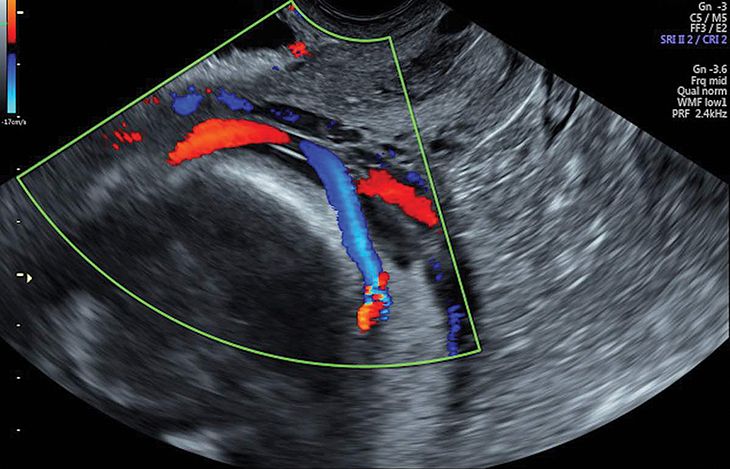
Table 1
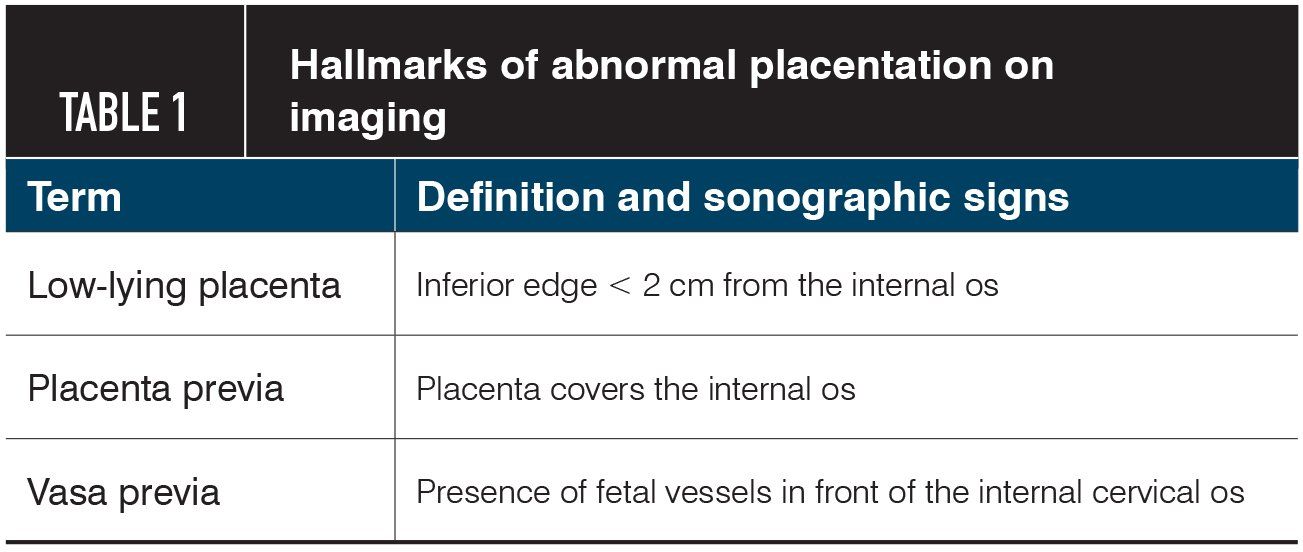
Introduction
Assessment of placental location in the mid-trimester fetal anatomic scan is a critical component of sonographic examination as recommended by various national and international guidelines.1,2 It allows for timely identification of at-risk pregnancies to ensure close surveillance for optimal peripartum management that minimizes maternal and neonatal morbidity and mortality.
Due to varying criteria used at different gestational ages, the true incidence of placenta previa is difficult to determine3, and at 18 to 23 weeks it has been reported to be around 5% when evaluated by transabdominal scan and 1.5% when evaluated by transvaginal scan.4 The majority resolve with advancing gestation with a 0.5% incidence reported at term. However, prevalence of placenta previa is on the rise5 and there are several risk factors for abnormal placentation, at the forefront of which is prior uterine instrumentation, whether it be cesarean delivery, dilatation and curettage or myomectomy. With each cesarean birth, the likelihood of placenta previa in a future pregnancy increases with reported relative risks of 4.5, 7.4, 6.5 and 44.9 for one, two, three and four prior cesarean sections, respectively.6 The risk is two-fold higher in case of pre-labor cesarean section in comparison to an intrapartum cesarean section.7 In addition, there are other predisposing factors to placenta previa such as higher-order gestation, advanced maternal age, grand multiparity and pregnancies resulting from assisted reproductive technology.5,8
Besides the maternal risks of bleeding antepartum, intrapartum, and postpartum, neonates born to mothers with placenta previa, especially with pregnancy bleeding, are at a higher risk for iatrogenic prematurity as well perinatal morbidity and mortality.8 In addition, there has been a reported mild increase in intrauterine growth restriction/small for gestational age in neonates from pregnancies with a placenta previa.9
A multisociety fetal imaging forum meeting in 2014 defined a low-lying placenta as having the inferior placental edge within 2 cm from the internal os, and a placenta previa where the placenta covers the internal os (Table 1).10 The forum also recommended abandoning the terms partial and complete placenta previa.
Presence of placenta previa increases risk of placenta accreta spectrum which has added comorbidities. Sonologists should be aware of the increased risk and should take all precautions for diagnosis and proper management of their patients.8
The aim of this review is to provide practical tips on diagnosis and management of a placenta previa.
Table 2
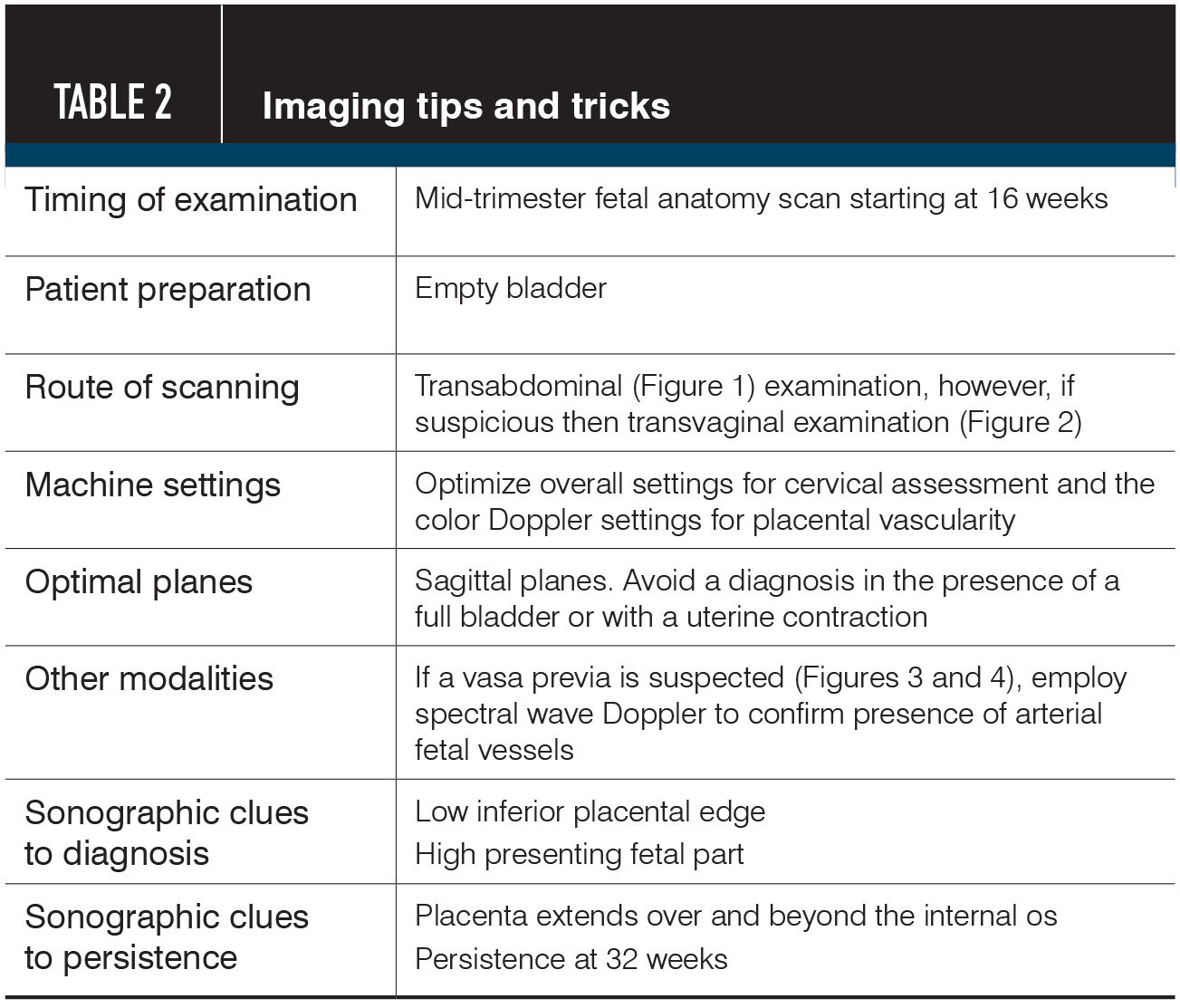
Figure 1 - Transabdominal examination at 23W1D of an anterior placenta previa shown to completely cover and extend beyond the internal cervical os (*).
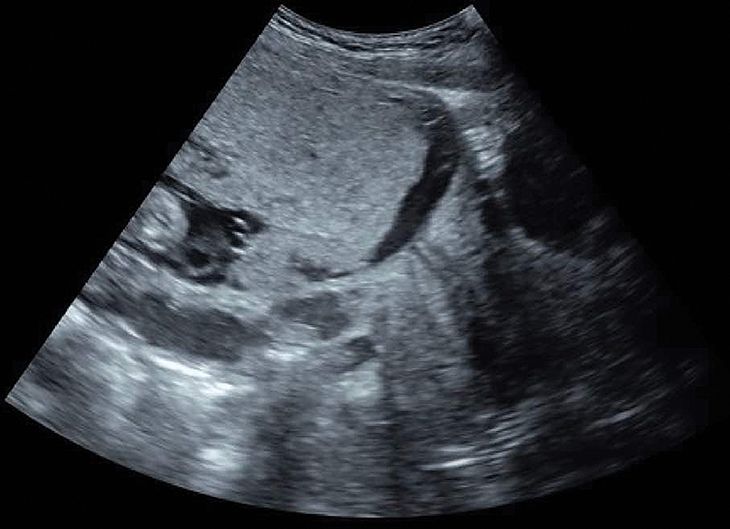
Figure 2 - Transvaginal examination at 21W5D of a posterior placenta previa shown to completely cover and extend beyond the internal cervical os (*).
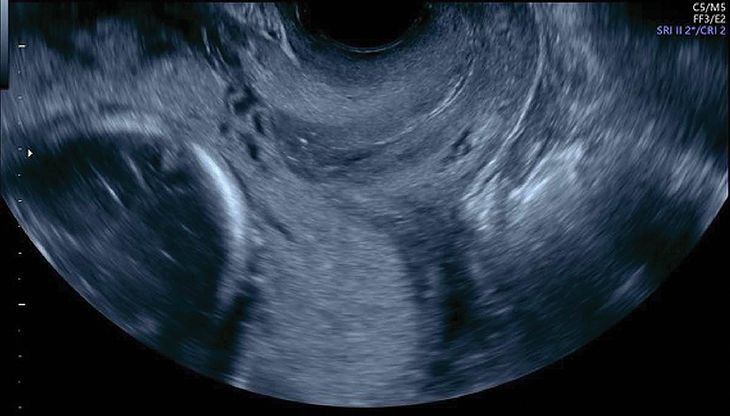
Figure 3 - Transvaginal examination at 26W6D of a vasa previa shown to completely cover internal os. Note the echolucent lines extending in front of the internal os.

Figure 4 - Transvaginal examination at 21W5D of a posterior placenta previa shown to completely cover and extend beyond the internal os (*).

Role of ultrasound in placental evaluation
The placenta may be visualized as early as 6 weeks by transvaginal sonography and 10 weeks transabdominally. It first appears as a focally thickened hyperechogenic rim of tissue around the gestational sac that is clearly separate from the myometrium. It is quite distinct and easily identifiable at 14 to 15 weeks and the intervillous blood flow may be documented using color Doppler.3,11
The relationship between the placental edge and the internal cervical os changes with advancing gestation. As such, it is very important not to label the patient as having a placenta previa prior to 16 weeks.12 The placenta “migrates” away from the internal os as the lower uterine segment develops and a rate of migration of 5.4 mm per week has been reported.13 Furthermore over 98.4% of suspected low lying/placenta previas in the second trimester resolve prior to delivery, at a mean gestational age of 26 weeks, with only 1.6% persisting at term.14 Though a prior cesarean section6 and higher parity are risk factors for having a placenta previa, parity does not impact the rate of persistence.15
Ultrasound plays a critical role in placental localization whether at the point-of-care setting or during screening examinations. Some of the earliest reports from 1977 suggested that a low lying or placenta previa in early pregnancy may be a normal variant.16 Though this was initially described transabdominally, the availability of transvaginal scanning since the 1980s has allowed for more accurate diagnoses.5,17
Several techniques can be employed to evaluate the placenta, the lower uterine segment, and cord insertion to screen for a placenta previa. It is important to note that presence of a full maternal bladder or uterine contractions may lead to false diagnosis of a placenta previa (Figures 1-4, Table 2).
A simple sonographic technique for placental localization has been described as part of a standardized 6-Step approach for performance of the focused basic obstetric ultrasound examination.18 This technique is described with the transducer held in a sagittal orientation just above the uterine fundus and moved to the lower abdomen in three sweeps (maternal right, left and center). Subsequently, the position of the lower placental edge with respect to the cervix is assessed. If it is less than 2 cm or the placenta is felt to cover the cervix then confirmation by transvaginal scan is indicated.5
In case of persistence of a placenta previa into the third trimester, it is critical to assess for possible presence of placenta accreta spectrum. Presence of placental lacunae, loss of the clear retroplacental echolucent space, presence of hypervascularity and bridging vessels, thinning of the myometrium, thinning of the retroplacental myometrial wall and the placental bladder interphase, and a “bulging” placenta into the posterior bladder wall are all concerning findings for a placental accreta spectrum.8
It must be kept in mind that if there were to be normalization of a low-lying placenta or a placenta previa with advancing gestation, it is important to rule out an ensuing vasa previa, which is associated with increased fetal mortality if undiagnosed prenatally. It has been estimated that approximately 28% of prenatally diagnosed pregnancies with vasa previas require an emergent preterm delivery.19 Presence of echolucent or circular lines overlying the internal os on transabdominal or transvaginal ultrasound should alert the examiner to the presence of vasa previa. This can be confirmed by transvaginal assessment with color and spectral Doppler, confirming presence of arterial fetal vessels.20,21 Nonetheless, approximately 39% of vasa previas resolve in the third trimester.22
Timing of the examination is key to arriving at the correct diagnosis. The rate of persistence of a placenta previa is directly related to the gestational age at sonographic diagnosis. It has been determined to persist in 12% of those diagnosed at 15-19 weeks; 34% at 20-23 weeks; 39% at 24-27 weeks; 62% at 28-31 weeks and 73% at 32-35 weeks.15 In addition, it is important to keep in mind several tips and tricks when evaluating for a low lying/previa as summarized in Table 2.
Figure 5

Management
Management of a placenta previa is dictated by gestational age and by whether the patient is bleeding or asymptomatic. Depending on the presentation, inpatient management may be warranted, and it is advisable to have blood banking capabilities. Ensuring maternal hemodynamic stability and fetal wellbeing are the primary goals. 23
As such, there are several considerations for both the clinician and patient to optimize outcomes and minimize risks, primarily those related to iatrogenic prematurity (Figure 5)24-26:
- Though data are lacking, it is highly advisable to instruct the patient to avoid sexual activity.27
- It is highly advisable to avoid digital examinations.27
- Once a placenta previa is diagnosed at the midtrimester scan, it is recommended to rescan at 32 then 36 weeks for assessment of normalization and for documentation of persistence.5
- In case of normalization, it is important to screen for vasa previa.
- In some cases, obtaining cervical length in asymptomatic patients may aid in management decisions. It helps identify patients at higher risk for preterm birth who may hemorrhage.5 Whenever evaluating the cervix, the author recommends utilizing color Doppler to rule out a vasa previa.
- Though data are inconclusive about the association of a placenta previa with fetal growth abnormalities,9 close surveillance of fetal growth and antenatal testing as indicated may be a consideration.
- Every attempt should be made to minimize iatrogenic preterm delivery while taking all precautions in case of bleeding and the need to deliver preterm. In anticipation of a preterm delivery, administration of antenatal steroids (and short-term tocolysis if safe for 48 hours) should be prioritized primarily in case of vaginal bleeding at 24 to 34 weeks.8
- It is important to correct maternal anemia and to administer Anti-D when indicated following a Kleihauer-Betke test for proper anti-D dosing.8
- Screening the patient for a possible placenta accreta spectrum, especially in the setting of prior cesarean deliveries, while taking all the necessary steps required for intraoperative management, is paramount.8
- Consultation with the neonatology team should be arranged to have the family discuss their wishes with the neonatology team, particularly in cases of peri-viability.8
- In case of cessation of vaginal bleeding for over 48 hours and where the patient is dependable and has reliable means of transportation, outpatient management is a consideration.8
- There is no evidence to support prophylactic cerclage in patients with a placenta previa.8
- Timing of delivery is dependent on several factors although an early-term birth at 36 to 37 6/7 weeks is recommended,24,25 without the need to verify fetal lung maturity via amniocentesis,24 to optimize maternal and neonatal outcomes. 28
- There is no evidence to support the need for general versus regional anesthesia in patients with a placenta previa and that should be left to the discretion of the anesthesiology team.8
Conclusion
Incidence of placenta previa is on the rise and is directly related to the number of prior cesarean sections. It leads to serious maternal and neonatal morbidity and mortality. Screening all patients and properly determining placental location, using transvaginal sonography beyond 16 weeks’ gestation, is critical to avoid causing undue parental anxiety by prematurely diagnosing a placenta previa in early gestation. Ob/gyns should be aware of placental migration and normalization of a placenta previa with advancing gestation. In case of normalization, it is important to screen for vasa previa. In case of persistence, precautionary steps should be taken to safeguard both mother and baby. Vigilance, a systematic approach, and following a standardized protocol help ensure optimal outcomes.
Disclosures:
The author reports no potential conflicts of interest with regard to this article.
References:
- AIUM–ACR–ACOG–SMFM–SRU practice parameter for the performance of standard diagnostic obstetric ultrasound examinations. J Ultrasound Med. 2018;37:E13-E24.
- Salomon LJ, Alfirevic Z, Berghella V, Bilardo C, HernandezâAndrade E, Johnsen SL, et al. Practice guidelines for performance of the routine midâtrimester fetal ultrasound scan. Ultrasound Obstet Gynecol. 2011;37:116-126.
- Kanne JP, Lalani TA, Fligner CL. The placenta revisited:radiologic–pathologic correlation. Probl Diagn Radiol. 2005;34(6):238-255.
- Taipale P, Hiilesmaa V, Ylöstalo P. Transvaginal ultrasonography at 18–23 weeks in predicting placenta previa at delivery. Ultrasound Obstet Gynecol. 1998;12:422-425.
- Jauniaux ERM, Alfirevic Z, Bhide AG, Belfort MA, Burton GJ, Collins SL, et al.. Placenta praevia and placenta accreta: diagnosis and management. Green-top Guideline No. 27a. BJOG. 2018.
- Ananth CV, Smulian JC, Vintzileos AM. The association of placenta previa with history of cesarean delivery and abortion: a meta-analysis. Am J Obstet Gynecol, 1997;177:1071-1078.
- Downes KL, Hinkle SN, Sjaarda LA, et al. Previous prelabor or intrapartum cesarean delivery and risk of placenta previa. Am J Obstet Gynecol 2015;212:669.e1-6.
- Oyelese Y, Smulian JC. Placenta previa, placenta accreta, and vasa previa. Obstet Gynecol. 2006;107(4):927-941.
- Balayla J, Desilets J, Shrem G. Placenta previa and the risk of intrauterine growth restriction (IUGR): a systematic review and meta-analysis. J Perinat Med. 2019;47(6): 577-584.
- Reddy UM, Abuhamad AZ, Levine D, Saade GR; Fetal Imaging Workshop Invited Participants. Fetal imaging: Executive summary of a joint Eunice Kennedy Shriver National Institute of Child Health and Human Development, Society for Maternal-Fetal Medicine, American Institute of Ultrasound in Medicine, American College of Obstetricians and Gynecologists, American College of Radiology, Society for Pediatric Radiology, and Society of Radiologists in Ultrasound Fetal Imaging Workshop. J Ultrasound Med. 2014;33:745-757.
- Fadl S, Moshiri M, Fligner CL, Katz DS Dighe M. Placental imaging: normal appearance with review of pathologic findings. RadioGraphics. 2017;37(3):979-998.
- Gallagher P, Fagan CJ, Bedi DG, Winsett MZ, Reyes RN. Potential placenta previa: Definition, frequency, and significance. Am J Roentgenol. 1987;149:1013-1015.
- Oppenheimer L, Holmes P, Simpson N, Dabrowski A. Diagnosis of low-lying placenta: can migration in the third trimester predict outcome? Ultrasound Obstet Gynecol. 2001;18:100-102.
- Heller HT, Mullen KM, Gordon RW, Reiss RE, Benson CB. Outcomes of pregnancies with a lowâlying placenta diagnosed on secondâtrimester sonography. J Ultrasound Med. 2014;33: 691-696.
- Dashe JS, McIntire DD, Ramus RM, Santos-Ramos R, Twickler DM. Persistence of Placenta Previa According to Gestational Age at Ultrasound DetectionObstetrics & Gynecology: May 2002 - Volume 99 - Issue 5 - p 692–697.
- Wexler P, Gottesfeld KR. Second trimester placenta previa: an apparently normal placentation. Obstet Gynecol. 1977:50:706-709.
- Farine D, Fox HE, Jakobson S, Timor-Tritsch IE. Vaginal ultrasound for diagnosis of placenta previa. Am J Obstet Gynecol. 1988;159(3):566-569.
- Abuhamad AZ, Zhao Y, Abuhamad S, Sinkovskaya E, Rao R, Kanaan C, et al. Standardized six-step approach to the performance of the focused basic obstetric ultrasound examination. Am J Perinatol. 2016;33(1):90-98.
- Society of Maternal-Fetal (SMFM) Publications Committee: Sinkey RG, Odibo AO, Dashe JS.#37 Diagnosis and Management of Vasa Previa. AJOG 2015;213(5):615-619.
- Bhide A, Thilaganathan B. Recent advances in the management of placenta previa. Curr Opin Obstet Gynecol. 2004;16:447-451.
- Lee W, Lee V, Kirk JS, Sloan C, Smith R, Comstock C. Vasa previa: prenatal diagnosis, natural evolution, and clinical outcome. Obstet Gynecol. 2000;95(4):572-576.
- Klahr R, Fox NS, Zafman K, Hill MB, Connolly CT, Rebarber A. Frequency of spontaneous resolution of vasa previa with advancing gestational age. AJOG. 2019 June 21 (ePub ahead of print).
- Lockwood CJ, Russo-Stieglitz K. Placenta previa management. UpToDate. July 23, 2019.
- Spong CY, Mercer BM, D’Alton M, Kilpatrick S, Blackwell S, Saade G. Timing of indicated late-preterm and early-term birth. Obstet Gynecol. 2011;118(2 Part 1):323-333.
- American College of Obstetricians and Gynecologists. Medically indicated late-preterm and early-term deliveries. ACOG Committee opinion no. 560. Obstet Gynecol. 2013;121:908-910.
- Gyamfi-Bannerman C. Society for Maternal-Fetal Medicine (SMFM) Consult Series #44: Management of bleeding in the late preterm period. SLOG 2018;218(1):B2-B8.
- Oyelese Y, Society for Maternal-Fetal Medicine. MFM consult: Evaluation and management of low-lying placenta or placenta previa on second trimester ultrasound. Contemp Ob/Gyn. December 2010:30-3.
- Robinson B, Grobman W. Effectiveness of timing strategies for delivery of individuals with placenta previa and accreta. Obstet Gynecol. 2010; 116(4):835-842.

S4E1: New RNA platform can predict pregnancy complications
February 11th 2022In this episode of Pap Talk, Contemporary OB/GYN® sat down with Maneesh Jain, CEO of Mirvie, and Michal Elovitz, MD, chief medical advisor at Mirvie, a new RNA platform that is able to predict pregnancy complications by revealing the biology of each pregnancy. They discussed recently published data regarding the platform's ability to predict preeclampsia and preterm birth.
Listen
